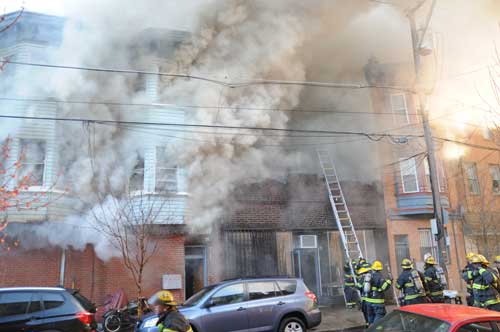Career Captain Dies Conducting Roof Operations at a Commercial Structure Fire - Pennsylvania
 Death in the Line of Duty…A summary of a NIOSH fire fighter fatality investigation
Death in the Line of Duty…A summary of a NIOSH fire fighter fatality investigation
F2013-07 Date Released: July 16, 2014
Executive Summary
On April 6, 2013, a 53-year old male career captain died from injuries suffered from a fall during roof operations at a commercial structure fire. The initial box alarm was for smoke in the basement of a fabric store. Approximately 30 – 45 minutes after smelling the odor of smoke, the store owner went to the basement to investigate and found a fire in the rear of the basement (southwest corner). He attempted to extinguish the fire with a portable fire extinguisher, but due to smoke and fire, he was forced to leave the basement. The 1st Alarm for companies assigned to Box 1232 had a difficult time finding the seat of the fire due to the amount of heat and smoke. Crews also struggled to gain access to the basement due to fabric and other products limiting aisle space. After the 2nd Alarm was struck, the Incident Commander ordered Ladder 27 (L27) to the roof to make a trench cut between the fire building and the Bravo Exposure. L27 accessed the roof from Side Charlie and were preparing to walk to the Bravo Exposure. The captain of L27 took several steps towards Side Alpha of the roof, which was obscured by smoke, and fell to the roof of a one-story storage building attached to the fire building. The captain died instantly. The other members of L27 heard the sound of the captain landing on the roof of a storage building. The driver/operator of L27 ordered the crew to their knees, conducted a personnel accountability report, and realized the captain was missing. The crew from L27 got off the roof and tried to locate the captain. They found him lying on the roof of the storage building and made several rescue attempts. Before the captain could be removed, the storage building roof collapsed into the basement of the fabric store. Rescue operations were started by breeching the wall of the storage building. Approximately 2 hours later, the captain was removed from the structure.

The crew of Ladder 27 was using a ground ladder to gain access to the roof of the fire building. The apartments with the bay windows are above the basement of the fabric store where the fire originated. This is showing Side Delta at the “C/D” corner of the incident.
(Photo courtesy of the fire department)
Contributing Factors
- Delay in reporting the fire to the fire department
- Fire in a non-sprinklered commercial building
- Building construction and design
- High fuel load and limited access to the fire due to excessive merchandise
- Lack of situational awareness.
Key Recommendations
- Fire departments should integrate current fire behavior research findings developed by the National Institute of Standards and Technology (NIST) and Underwriter’s Laboratories (U.L.) into operational procedures by developing standard operating procedures, conducting live fire training, and revising fireground tactics
- Fire departments should consider implementing a pre-incident planning program which complies with NFPA 1620, Standard on Pre-Incident Planning
- To enhance situational awareness, consider implementing a critical building information system which is available to responding units
- Based upon department procedures, the strategy and tactics of an occupancy should be defined by the organization for fire-fighting operations
- Fire departments should review procedures on the use and deployment of Rapid Intervention Team(s)
- Ensure all fire fighters and fire officers are trained when to call a “Mayday”
- Fire departments should provide the Incident Commander with a “Mayday” tactical checklist in the event of a “Mayday”.
The National Institute for Occupational Safety and Health (NIOSH), an institute within the Centers for Disease Control and Prevention (CDC), is the federal agency responsible for conducting research and making recommendations for the prevention of work-related injury and illness. In 1998, Congress appropriated funds to NIOSH to conduct a fire fighter initiative that resulted in the NIOSH “Fire Fighter Fatality Investigation and Prevention Program” which examines line-of-duty-deaths or on duty deaths of fire fighters to assist fire departments, fire fighters, the fire service and others to prevent similar fire fighter deaths in the future. The agency does not enforce compliance with State or Federal occupational safety and health standards and does not determine fault or assign blame. Participation of fire departments and individuals in NIOSH investigations is voluntary. Under its program, NIOSH investigators interview persons with knowledge of the incident who agree to be interviewed and review available records to develop a description of the conditions and circumstances leading to the death(s). Interviewees are not asked to sign sworn statements and interviews are not recorded. The agency’s reports do not name the victim, the fire department or those interviewed. The NIOSH report’s summary of the conditions and circumstances surrounding the fatality is intended to provide context to the agency’s recommendations and is not intended to be definitive for purposes of determining any claim or benefit.
